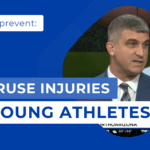How to care for a sprained ankle
 The “ankle sprain” is a very common injury. Ankle sprains may occur when you lose your balance and put pressure on your ankle(s). Typically the pain quickly fades away, and you go on your way. However, the sprain could be more severe; your ankle might swell, which can make it difficult to stand. If it’s a severe sprain, you might have felt a “pop” when the injury happened.
The “ankle sprain” is a very common injury. Ankle sprains may occur when you lose your balance and put pressure on your ankle(s). Typically the pain quickly fades away, and you go on your way. However, the sprain could be more severe; your ankle might swell, which can make it difficult to stand. If it’s a severe sprain, you might have felt a “pop” when the injury happened.
You could have long-term problems if the sprain is not treated properly. If the sprain is severe, you will typically need an X-ray to differentiate from a broken bone. Also, if you are unable to put weight on your foot after this type of injury, or if there is significant swelling, bruising, or deformity, you should seek medical treatment from a doctor immediately.
Depending on how many ligaments are injured, your sprain is classified as Grade 1 (mild), 2 (moderate), or 3 (severe).
Treatment
Treating your sprained ankle may prevent chronic pain and looseness. For a Grade 1 (mild) sprain, follow the R.I.C.E. guidelines:
- Rest your ankle by not walking on it. Limit weight-bearing and use crutches if necessary. You are safe to put some weight on the leg if there is no broken bone. An ankle brace may help control swelling and add stability while the ligaments are healing.
- Ice it to keep down the swelling. Don’t ice more than 20 minutes at a time to avoid frostbite, and don’t put ice directly on the skin (use a thin piece of cloth such as a pillowcase between the ice bag and the skin).
- Compression can help control swelling as well as immobilize and support your injury.
- Elevate the foot by reclining and propping it up above the waist or heart as needed.
For a Grade 2 (moderate) sprain, follow the R.I.C.E. guidelines and allow more time for healing. A doctor may immobilize or splint your sprained ankle.
A Grade 3 (severe) sprain puts you at risk for permanent ankle instability. Surgery may be needed to repair the damage on rare occasions. For severe ankle sprains, your doctor may also consider treating you with a short leg cast for 2-3 weeks or a walking boot. People who sprain their ankle repeatedly may also need surgical repair to tighten their ligaments.
Rehabilitating Your Sprained Ankle
Every ligament injury needs rehabilitation. Otherwise, your sprained ankle might not heal completely, and you might re-injure it. All ankle sprains, from mild to severe, require three phases of recovery:
- Phase 1 includes resting, protecting, and reducing swelling of your injured ankle.
- Phase 2 includes restoring your ankle’s flexibility, range of motion, and strength.
- Phase 3 includes gradually returning to straight-ahead activity and doing maintenance exercises, followed later by more cutting sports such as tennis, basketball, or football.
To prevent future sprained ankles, pay attention to your body’s warning signs to slow down when you feel pain or fatigue and stay in shape with good muscle balance, flexibility, and strength.
Speak with an Orthopedic Specialist Today
Are you suffering from a recent injury? Make an appointment with one of our orthopedic specialists today to start your healing journey. OrthoArizona has nearly two dozen offices throughout the Valley, each focused on quality care, compassion, and excellent customer service. Since 1994, OrthoArizona has been dedicated to compassionate care of the highest quality.
The advice and information contained in this article are for educational purposes only and are not intended to replace or counter a physician’s advice or judgment. Please always consult your physician before taking any advice learned here or in any other educational, medical material.











